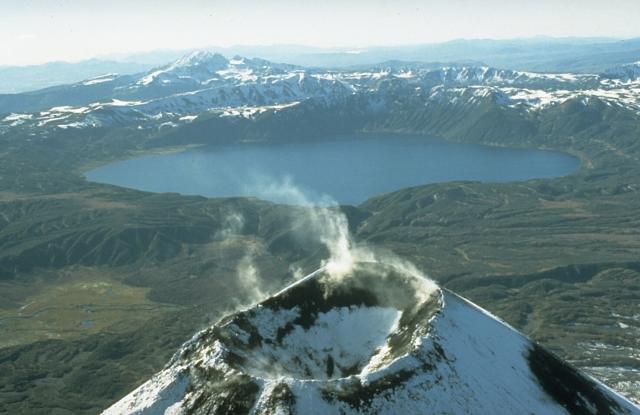Geologic features that are often associated with volcanoes or volcanic areas include craters, calderas, volcanic vents, geysers, and hot springs.
Craters, Calderas, and Vents
 |
| Crater |
 |
| Vent |
Depressions commonly found at the top of volcanoes are craters. Craters form by explosion or collapse of the upper portion of the volcanic cone and may be flat floored or funnel shaped. They are usually a few kilometres in diameter.
Calderas are gigantic, often circular, depressions resulting from explosive ejection of magma and subsequent collapse of the upper portion of the volcanic cone. They may be 20 or more kilometres in diameter and contain volcanic vents, as well as other volcanic features, such as gas vents and hot springs. Volcanic vents are openings through which lava and pyroclastic debris are erupted at the surface of Earth.
Vents may be roughly circular conduits, and eruptions construct domes and cones. Other vents may be elongated fissures or rock fractures, often normal faults, which produce lava flows. Some extensive fissure eruptions have produced huge accumulations of nearly horizontal basaltic lava flows called flood basalts. The best-known flood basalt deposit in the United States is the Columbia Plateau region in parts of Washington, Oregon, and Idaho, where basalt covers a vast area.
Hot Springs and Geysers
Hot springs and geysers are hydrologic features found in some volcanic areas. Groundwater that comes into contact with hot rock becomes heated, and, in some cases, the heated water discharges at the surface as a hot spring, or thermal spring. In rare cases, the subsurface groundwater system involves circulation and heating patterns that produce periodic release of steam and hot water at the surface, a phenomenon called a geyser. World-famous geyser basins or fields are found in Iceland, New Zealand, and Yellowstone National Park in Wyoming.
Caldera Eruptions
Calderas are produced by very rare, but extremely violent, eruptions. Although none have occurred anywhere on Earth in the last few hundred thousand years, at least 10 caldera eruptions have occurred in the last million years, three of them in North America. A large caldera-forming eruption may explosively extrude up to 1000 cubic km (240 ) of pyroclastic debris, consisting mostly of ash. This is approximately 1000 times the quantity ejected by the 1980 eruption of Mount St. Helens! Such an eruption could produce a caldera more than 10 km (6.2 mi) in diameter and blanket an area of several tens of thousands of square kilometres with ash. These ash deposits can be 100 m (328 ft) thick near the craters rim and a meter or so thick 100 km (62 mi) away from the source.6 The most recent caldera-forming eruptions in North America occurred about 600,000 years ago at Yellowstone National Park in Wyoming and 700,000 years ago in Long Valley, California. The area covered by ash in the eruption event, which produced the Long Valley caldera near the famous Mammoth Mountain ski resort. The most recent volcanic eruptions at Long Valley were about 400 years ago. Measurable uplift of the land, accompanied by swarms of earthquakes up to M 6 in the early 1980s, suggested magma was moving upward, prompting the U.S. Geological Survey to issue a potential volcanic hazard warning that was subsequently lifted. However, the future of Long Valley remains uncertain. The main events in a caldera-producing eruption can occur quickly in a few days to a few weeks but intermittent, lesser-magnitude volcanic activity can linger on for a million years. Thus, the Yellowstone event has left us hot springs and geysers, including Old Faithful, while the Long Valley event has left us a potential volcanic hazard. In fact, both sites are still capable of producing volcanic activity because magma is still present at variable depths beneath the caldera floors. Both are considered resurgent calderas because their floors have slowly domed upward since the explosive eruptions that formed them. The most likely future eruptions for Long Valley or Yellowstone would be much smaller than the giant caldera eruptions that occurred hundreds of thousands of years ago.

